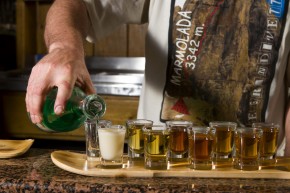Whether you're returning from a long hike, finishing up a day of biking the trails or just relaxing after a day of taking in the breathtaking sights of the Dolomite mountains, there's no doubt you've worked up a thirst.
Thirsty travelers visiting this region are not to be disappointed. The area is not only home to a delectable array of fine dining and ethnic foods but also boasts a wide selection of beverage choices such as wine, spirits and coffee concoctions.
Given the fact that the Dolomites are primarily located in Italy, it's no surprise that the wines of this region are rich, plentiful and sure to please even the most discriminating wine connoisseur. Many of the valleys and hills of the Dolomites are home to their own vineyards and wineries, with the sunlight and seasons offering favorable conditions for growth. There are three grapes native to the Dolomites: the white nosiola and the red teroldego rotoliano and the marzemino.
Red wine drinkers visiting the Dolomites can enjoy the rich, full bodied flavors of the local merlots, cabernet sauvignons and cabernet francs. The slopes around Bolzano and Trentino produce the native blends of teroldego, shiava and blauburgunder. Those who prefer the white variety will find pinot bianco, pinot grigio and chardonnay. Traminer, another white blend that hails from Austria, is described as deliciously floral and extremely light bodied.
The village of Trentino has earned its own place on the map as Italy's largest producer of chardonnay. It's also known for producing sparkling wines by way of the traditional method and boasts a sweet wine called vino santo, which is made from dried grapes and is considered somewhat more rare than the other wines of the area. And for those hot summer days, visitors are encouraged to enjoy a holundersaft; a refreshing juice made from ripe elderberries.

Aside from wine, the Dolomites is also home to a distilled spirit called grappa, which is unique to Italy. Grappa is made from the solid remains of grapes that are left over from winemaking, primarily comprised of the skins but also including the stems, seeds and yeast residue. The grappa is aged for six months in wooden casks, stored another six months in air-tight glass carboys and then refined and bottled for consumption.
The flavor of grappa depends on the variety of grape used, but it is generally described as dry and is quite potent. In fact, Italians refer to grappa as "firewater" because it is a particularly strong drink, usually between 80 and 90 proof. It's highly aromatic, warm, smooth and distinctly fruity -- and is typically enjoyed after a meal. Some people add grappa to espresso to create a "caf? corretto," another popular after dinner treat.
For visitors who prefer coffee over wine and spirits, the Dolomites offers delicious concoctions that are sure to please. Primarily taken as short, black espresso shots -- espresso solo or espresso doppio for a single or double shot, respectively -- it is also available in a wide variety of espresso drinks. Some of the most popular include:
Cappuccino: very popular, traditionally made with equal parts espresso, steamed milk and frothed milk.
Caff? breva: cappuccino with half and half instead of whole milk.
Caff? latte: a single shot of espresso combined with steamed milk, with a 3:1 ratio of milk to coffee.
Caff? mocha: basically a caff? latte with chocolate powder or chocolate syrup
Cafe con leche: 1.5 ounces of espresso with eight ounces of steamed milk
Cafe macchiato: a shot of espresso topped off with a dollop of frothed milk. Translated literally, it means spotted coffee.
Americano: a single shot of espresso with six to eight ounces of hot water added. This is the closest thing to brewed coffee available, but because it's not brewed in a full carafe, it results in a stronger brew than normal drip coffee.
Ristretto: a very strong, "restricted" shot. Only about one-half of the water is allowed to come through the coffee grounds, but the shot takes the same amount of time as a normal pull, ensuring the strength of the espresso.
Lungo: the opposite of a ristretto; an extra long pull allowing approximately twice as much water through the same amount of coffee as normally used for a single shot.
Caff? Romano: regular espresso with a twist of lemon or lemon peel.
Caff? corretto: Espresso "corrected" with a shot of grappa, brandy, cognac or other liqueur. It is ordered including the name of the desired liquor (for example "un caff? corretto a grappa").
Given the rich culture of the Dolomites, and the delectable dishes of traditional foods served throughout the region, it's no surprise that those traveling to this area can also expect to find a wide array of beverage choices. And as with most things in the Dolomites, the drinks served here are rooted in tradition and unique to the location, giving those who partake in them a little taste of the history and beauty that surrounds them.
?
trans siberian orchestra little big town little big town bennett bennett daniel day lewis patti stanger
No comments:
Post a Comment
Note: Only a member of this blog may post a comment.